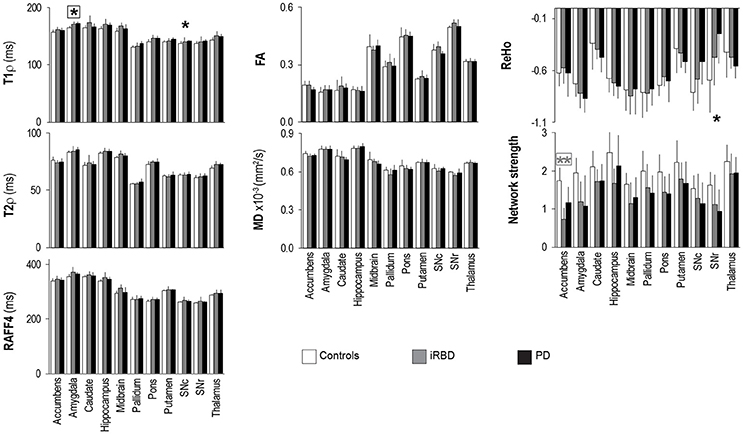
94% of researchers rate our articles as excellent or good
Learn more about the work of our research integrity team to safeguard the quality of each article we publish.
Find out more
CORRECTION article
Front. Neurosci. , 26 June 2018
Sec. Brain Imaging Methods
Volume 12 - 2018 | https://doi.org/10.3389/fnins.2018.00446
This article is a correction to:
Multi-modal Brain MRI in Subjects with PD and iRBD
 Silvia Mangia1*
Silvia Mangia1* Alena Svatkova2,3
Alena Svatkova2,3 Daniele Mascali4
Daniele Mascali4 Mikko J. Nissi5
Mikko J. Nissi5 Philip C. Burton1
Philip C. Burton1 Petr Bednarik1,3
Petr Bednarik1,3 Edward J. Auerbach1
Edward J. Auerbach1 Federico Giove4,6
Federico Giove4,6 Lynn E. Eberly7
Lynn E. Eberly7 Michael J. Howell8
Michael J. Howell8 Igor Nestrasil2
Igor Nestrasil2 Paul J. Tuite8
Paul J. Tuite8 Shalom Michaeli1
Shalom Michaeli1A corrigendum on
Multi-modal Brain MRI in Subjects with PD and iRBD
by Mangia, S., Svatkova, A., Mascali, D., Nissi, M. J., Burton, P. C., Bednarik, P., et al. (2017). Front. Neurosci. 11:709. doi: 10.3389/fnins.2017.00709
In the original paper there were errors in Figure 4 and in the text at page 7. Figure 4 erroneously reported four asterisks, namely on top of T1ρ of putamen, T2ρ of midbrain, RAFF4 of midbrain, and ReHo of amygdala. The figure also did not report one asterisk on top of T1ρ of SNc. The correct version of Figure 4 appears below.

Figure 4. Group summaries of T1ρ, T2ρ, RAFF4, FA, MD, ReHo and network strength. N = 10, 8, 9 in the control, iRBD and PD groups, respectively, for T1ρ, T2ρ, and RAFF4, whereas N = 9, 8, 9 for FA and MD, and N = 10, 8, 8 for network strength and ReHo. Data shown as mean ± SD. * and ** indicate, respectively, p < 0.05 and p < 0.005 with age-adjustments after Holm's correction (gray: iRBD vs. controls; black: PD vs. controls). Asterisks within a box indicate p < 0.05 after correcting FDR for multiple testing (7 modalities).
In addition, the text at page 7 “Group differences between PD and controls were also observed for T2ρ in the amygdala (p = 0.033) and thalamus (p = 0.08)” should read as “Group differences between PD and controls were also observed for T2ρ in the amygdala (p = 0.033) and thalamus (p = 0.008)”.
The authors sincerely apologize for these errors that may cause confusion for the reader. These errors however do not change the interpretation of the results and the main message of the study in any way, because the interpretation was based on the correct results reported in the Supplementary Table.
The original article has been updated.
The authors declare that the research was conducted in the absence of any commercial or financial relationships that could be construed as a potential conflict of interest.
Keywords: rotating frame MRI, Parkinson's disease, iRBD, functional connectivity, DTI
Citation: Mangia S, Svatkova A, Mascali D, Nissi MJ, Burton PC, Bednarik P, Auerbach EJ, Giove F, Eberly LE, Howell MJ, Nestrasil I, Tuite PJ and Michaeli S (2018) Corrigendum: Multi-modal Brain MRI in Subjects with PD and iRBD. Front. Neurosci. 12:446. doi: 10.3389/fnins.2018.00446
Received: 30 April 2018; Accepted: 12 June 2018;
Published: 26 June 2018.
Edited and reviewed by: Kevin J. Black, Washington University in St. Louis, United States
Copyright © 2018 Mangia, Svatkova, Mascali, Nissi, Burton, Bednarik, Auerbach, Giove, Eberly, Howell, Nestrasil, Tuite and Michaeli. This is an open-access article distributed under the terms of the Creative Commons Attribution License (CC BY). The use, distribution or reproduction in other forums is permitted, provided the original author(s) and the copyright owner are credited and that the original publication in this journal is cited, in accordance with accepted academic practice. No use, distribution or reproduction is permitted which does not comply with these terms.
*Correspondence: Silvia Mangia, bWFuZ2lhQHVtbi5lZHU=
Disclaimer: All claims expressed in this article are solely those of the authors and do not necessarily represent those of their affiliated organizations, or those of the publisher, the editors and the reviewers. Any product that may be evaluated in this article or claim that may be made by its manufacturer is not guaranteed or endorsed by the publisher.
Research integrity at Frontiers

Learn more about the work of our research integrity team to safeguard the quality of each article we publish.